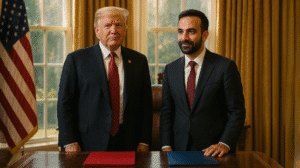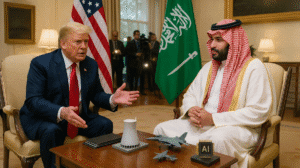In a critical step in Syria’s fragile shift toward political restructuring, Syria’s interim president, Ahmed al-Sharaa, formally announced the formation of a new 23-member transitional government on March 29, 2025. This development comes four months after the ousting of former President Bashar al-Assad, ending over two decades of authoritarian rule. Al-Sharaa described the cabinet as a broad-based administration intended to initiate national reconciliation, stabilize state institutions, and begin structural reforms.
Cabinet Composition and Diversity
The new government includes figures from across Syria’s diverse religious and ethnic spectrum, an intentional shift from the sectarian and exclusionary policies of previous regimes. Among the more prominent names is Hind Kabawat, a Christian lawyer and civil society advocate known for her work in promoting interfaith dialogue and women’s rights. She now leads the Ministry of Social Affairs and Labor. Yarub Badr, an Alawite technocrat who previously held ministerial posts before distancing himself from the Assad regime, has been appointed as Minister of Transport. Amjad Badr, representing the Druze minority, will head the Ministry of Agriculture. These appointments are part of a broader effort to reflect Syria’s multi-sectarian identity and to reassure minority communities that they have a place in the country’s political future.
Balancing Continuity and Reform
While the transitional cabinet features several new faces, there is also continuity with the post-Assad caretaker government. Murhaf Abu Qasra continues as Minister of Defense, while Asaad al-Shaibani retains his post as Foreign Minister. This continuity is seen by observers as a practical move to preserve stability within the state apparatus during an uncertain transitional phase. The government also introduces new ministries that signal a forward-looking agenda. The newly established Ministry of Emergency and Disaster Management will be led by Raed al-Saleh, former head of the White Helmets, who played a key role in civil defense during the war. Another addition is the Ministry of Youth and Sports, created to address growing social unrest and disengagement among young Syrians.
Centralization of Executive Power
One of the more controversial aspects of the new political arrangement is the elimination of the prime minister’s office under the interim constitution ratified earlier this month. Executive power is now fully concentrated in the presidency. Government officials claim this measure is temporary and designed to streamline governance during a national crisis, but critics warn that it could lead to a new concentration of authority reminiscent of Assad-era structures. Political analysts argue that genuine transition will require institutional checks and balances—something currently lacking in this configuration.
Cautious Optimism and Lingering Concerns
Although the cabinet’s diversity and the inclusion of former opposition members have been praised, skepticism remains among some domestic and exiled opposition groups. Critics argue that the process behind the appointments lacked transparency, and they point to the continued dominance of security figures—eight ministers have military or intelligence backgrounds—as a worrying sign. Human rights organizations are also calling for a clear roadmap to transitional justice, fearing that a lack of accountability for past crimes could undermine public trust and the legitimacy of the new administration.
International Response and the Road Ahead
Reactions from the international community have been cautiously supportive. The United Nations and European Union issued statements welcoming the formation of the transitional cabinet as a necessary step toward political normalization. However, they emphasized the need for a clearly defined constitutional process and a commitment to holding free and fair elections in the near future. The United States echoed those sentiments, warning that Syria’s new leadership must not replicate the authoritarian tendencies of the past and should prioritize institutional reform and civil liberties.
A Final Note
The announcement of Syria’s transitional government under President Ahmed al-Sharaa represents a pivotal moment for a country still grappling with the aftermath of civil war and decades of repressive rule. While the new cabinet offers signs of inclusive governance and structural innovation, the true test lies ahead. Success will depend on the administration’s ability to maintain stability, enact meaningful reforms, and engage the population in an open political process. This was notably echoed by al-Sharaa himself during the announcement, where he remarked that this government is not a destination, but a bridge—one meant to carry Syria toward a future rooted in sovereignty, justice, and unity.
















